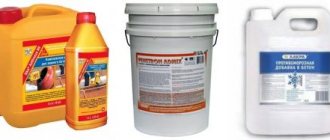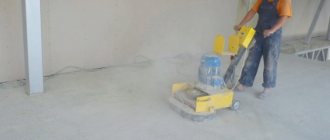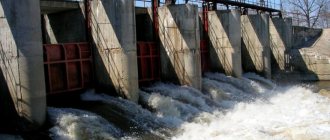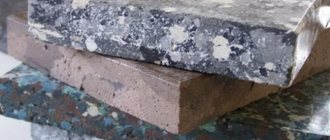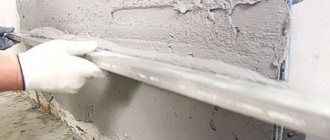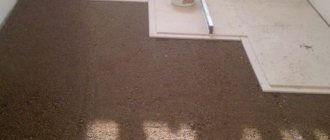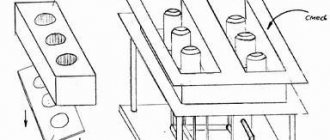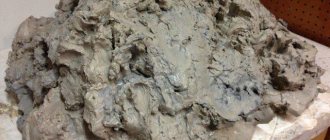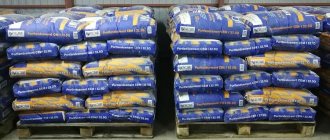What are dry construction mixtures
Dry building mixtures are widely popular in the field of construction and repair. They are easy to prepare and apply. Dry mixtures belong to the group of auxiliary building materials that are used for interior and exterior decoration of premises. Immediately after dilution with water, they become suitable for use and are used for plastering, laying tiles, brickwork, etc. Precise dosage of all components of the composition and compliance with the rules for mixing the starting materials make it possible to obtain high-quality solutions for use in various fields of construction.
Classification of dry mixtures for construction
Modern mixtures are used for various types of work, so they are usually divided into:
- masonry – thick-layer and thin-layer;
- adhesive – mounting, facing. Used for laying tiles and porcelain tiles, aerated concrete blocks, bricks, etc.;
- floor - for leveling, making screeds, creating a finishing layer. They are ordinary and self-leveling;
- repair - injection, volumetric - and surface-restorative;
- insulating – used to create heat and sound insulation;
- plastering – light, special and heavy;
- putty – leveling and to create a finishing layer;
- grout - for grouting joints up to 6 millimeters thick, and joints more than 6 millimeters wide;
- universal - mixtures that can be used for various construction and repair work.
Dry mixtures are also classified according to the composition of the binder - they can be simple or complex. To create simple mixtures, only one binder is used, for example, cement or gypsum. In complex mixtures, several binder additives are used simultaneously.
In addition, dry mixtures are divided into special and universal, which can be used for most repair and construction work. So, for example, leveling mixtures for putty are often used when pouring floors, starting finishing of wall panels, etc.
Dry mixtures are used for both internal and external work. When carrying out work inside buildings, gypsum mixtures are most often used, thanks to which a microclimate favorable for humans is maintained in the room. When carrying out external work, mixtures are used that are based on cement - a substance that is highly resistant to moisture, fire-resistant and resistant to atmospheric conditions.
Dry mixtures are classified according to the dispersion of the filler - they can be finely dispersed - the filler fraction does not exceed 0.315 mm, and coarse - the fraction is 2.5 mm and above.
Types of mixtures and their main parameters
First of all, all products of this type are divided into groups depending on which component is used as the main filler; there are gravel, crushed stone and sand mixtures.
Bitumen of different viscosities is also used, because of this the installation method may differ:
- Hot asphalt concrete mixtures are laid at a temperature of at least 120 degrees; both liquid and viscous bitumens are used for their production . For large-scale objects and roads with high loads and heavy traffic, this option is used, since it can be used to lay a high-quality and durable coating.
Working with hot asphalt requires special laying equipment; without it it is impossible to achieve a good result
- Warm asphalt concrete mixtures (many experts call them completely cold) can be laid at lower temperatures . The lower temperature limit is 5 degrees Celsius, but it is still better to carry out work at 20-30 degrees. Only liquid bitumen is used in production.
Bitumen is the most important component, the quality of which largely determines the strength of asphalt
Worth remembering! The finished composition should be used for a maximum of 2-3 hours (depending on the brand). Otherwise, the bitumen will harden and it will become impossible to work.
Another important factor is the density of the asphalt concrete mixture.
| Type of composition | Percentage of residual porosity | Scope of application |
| High density | 1%-2.5% | Highways with heavy traffic |
| Dense | 2.5%-5% | Moderate roads |
| Porous | 5.0%-10% | Pedestrian and bicycle paths |
| Highly porous | 10%-18% | As a substrate for more durable compounds |
You can also divide all compositions into fractions:
- If there are inclusions with a diameter of up to 40 mm - coarse-grained.
- For fragments up to 20 mm in size - fine-grained.
- If the size of the largest inclusions does not exceed 5 mm, it is sandy.
Depending on the amount of crushed stone present in the composition, the following types of asphalt concrete mixtures are distinguished:
- “A” - this designation indicates that the content of crushed stone in the total volume of the composition ranges from 50 to 60%.
- “B” means that the finished asphalt concrete composition contains from 40 to 50% crushed stone filler.
- “B” is an abbreviation used to designate compositions in which 30-40% crushed stone is present.
Important! Crushed stone for the production of road mixtures must contain a certain percentage of flat (flaky) shaped fragments; the number of such fragments, depending on the brand of the composition, can range from 15 to 35%.
Composition of dry mixtures
The basis of the mixtures can be gypsum, polymers and cement; various additives are also added to them, giving the composition the necessary quality characteristics. Substances used in the production of dry mixtures are conventionally grouped into several groups:
- Mineral binders - lime, Portland cement, gypsum.
- Organic binders are polymer powders based on ethylene, vinyl chloride, acrylate.
- Fillers – chalk, quartz sand, amorphous silica, talc, asbestos, vermiculite.
- Water-retaining additives, plasticizers and substances that regulate the setting of the material.
Binder components are added to mixtures in order to increase their strength characteristics and adhesion. A distinction is made between hydraulic and non-hydraulic components. Hydraulic ones give the mixture high resistance to water.
Scope of use of dry mixtures for construction
Dry mixtures can be used in almost all types of work related to the construction and renovation of premises. So, for example, the M150 mixture, created on the basis of sand and Portland cement, is used:
- for processing joints and seams;
- laying bricks, porcelain stoneware, paving slabs;
- when carrying out plastering work;
- for leveling any surfaces;
- when concreting stairs;
- during the repair of floors and other reinforced concrete structures.
The M150 mixture is quickly applied to the surface and hardens within 24 hours.
Dry mixture M200 can be used for laying bricks and aerated concrete blocks, pouring foundations, and when carrying out plastering work. It contains Portland cement, sand, and modified additives. The mixture was created taking into account the requirements of GOST 28013-98. Material consumption is 10 kg per 1.9 liters of clean water.
M300 is a self-leveling mixture, the main difference of which is its fast hardening time. It is used not only for leveling floors, but also for pouring foundations, load-bearing structures, brickwork, and fastening reinforced concrete structures. The M300 mixture is characterized by maximum strength indicators, resistance to high humidity and temperature changes.
Specifications
Sand concrete M300 is a universal composition, suitable for a wide range of repair and construction work, which is explained by the high strength of the material. Thus, the compressive strength of the M300 brand is 300 kg/cm2 - that is, one square centimeter can easily withstand a weight of up to 300 kilograms.
The density of the mixture is optimal for this type of solution, which is ensured by the correct selection of the volume of sand, which fills all the voids and does not allow voids to appear in the monolith during pouring. The frost resistance of the M300 mixture is F50 - the frozen stone can withstand 50 freezing/thawing cycles without loss of properties or deformation.
The solution consumption is about 17-30 kilograms per square meter with a layer thickness of up to 10 millimeters. This makes the screed cheaper, especially when compared with specialized compounds. M300 demonstrates good moisture resistance and hardens quickly, so it is actively used in emergency repairs, when you need to quickly and without any preparation repair cracks and crevices and restore strength and stability.
The composition sets within 12 hours after mixing with water (you can already walk on the screed), and finally hardens in an average of 5 days (when it is already possible to continue the construction process).
The viability of a freshly prepared solution is 2 hours, the composition has a self-leveling ability, so working with it is comfortable even for non-professionals.
The solution is quite plastic, so it can be applied in a thin/thick layer and has a wide range of applications. It does not shrink, adhesion is 4 kg/cm2, you can work with the mixture at temperatures below +5 degrees. And thanks to its ability to resist corrosion, concrete is also suitable for pouring reinforced concrete and other types of structures.
The table below presents the main characteristics of the M300:
Currently reading: How to reinforce concrete with carbon fiber (concrete and reinforced concrete structures)
Advantages of dry construction mixtures
Due to their special composition and ease of preparation, building mixtures are widely popular in the construction industry. The main advantages of dry mixtures include the following factors:
- Easy to use and prepare - the packaging of each mixture contains instructions, following which you can obtain a high-quality and ready-to-use solution.
- Stability of the composition - all components are added to the dry mixtures in strictly dosed form, so any composition retains all the specified characteristics.
- Cost-effective – the use of building mixtures helps to save costs, since the solution is applied in a thinner layer. In addition, the time spent on finishing is significantly reduced, which is important.
- Uniformity and plasticity - if the instructions are followed, the solution turns out to be homogeneous and can be applied well to any surface.
- High adhesive qualities – reliable adhesion to almost any base.
- Excellent sound and heat insulation properties.
- Long shelf life - even with long-term storage, the mixtures do not lose their original characteristics. They can be transported and stored even at low temperatures.
- Environmentally friendly - all mixtures intended for repair and construction are absolutely safe for human life, therefore they can be used for both external and internal work.
When choosing mixtures for work, it is best to follow the rule of choosing materials from one manufacturer - they are perfectly combined with each other, guaranteeing quality and long service life.
What can you save on when installing a floor?
Manufacturers do not recommend saving on professional performance of work and the cost of materials. The performance characteristics of the entire room will depend on the quality of the dry mixtures used. To avoid unnecessary costs , it is recommended to calculate the mixture consumption for specific repair conditions based on the type of room, its area, and design . The calculation can be carried out independently using special services offered by manufacturers on official websites (for example, Henkel, Roussean).
